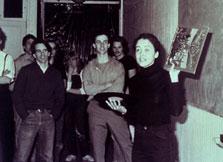Oh sure, Adrian Piper has a vicious sense of irony, but I never knew that she could groove. And there she is, in her video Funk Lessons, amid a throng of sweaty dancers, streaking across the floor like a woman possessed by the soul of funk music.
Piper’s rhythm is one of many revelatory aspects of curators Pan Wendt and Luis Jacob’s new show Funkaesthetics at Hart House’s Barnicke Gallery, which collects a wide variety of art and ephemera to posit a kind of theory of funk. This, of course, makes the show sound more staid and stuffy than it actually is. In point of fact the show, in its raucous assemblage of artifacts across media, national and sexual borders, and decades is, most importantly, fun.
The show is laid out across the two galleries of the Barnicke like a brain. The East Gallery is where the analysis takes place, where logical and historical connections are made and the theory of funk is elucidated. As Pedro Bell’s The Electric Spanking of War Babies — a series of comic-book-inflected drawings of byzantine detail rife with images of social unrest and black alienation and exploitation — makes clear, funk is not simply a musical style. Its birth, at the emergence of the ’60s civil rights movement (and, not coincidentally, of rock ’n’ roll) points to a wider significance. The videos of Sun-Ra — a jazz bandleader who fashioned himself into a space-age-Egyptian-mythology funk ambassador — expound on this. The initial corniness of each video’s setup (landing a boombox-shaped spaceship in the middle of a press conference? Teleporting into a black youth community centre in full Egyptian drag? Communing with funk spirits in the middle of a dark forest?) gives way to a sobering message. In the community centre video a pragmatic Afroed girl confronts the glitzy Sun-Ra: “What are you, for real?” His response is that he isn’t real. He’s a myth. White America doesn’t believe in black people; they’re all myths. Their exuberance, their funk, is their revenge on a world that won’t believe in them.
Sun-Ra’s response immediately called to mind a line from Tony Kushner’s Angels in America: “Faggots. We’re just a bad dream the real world is having, and the real world is waking up.” Funk’s exuberance, its sheer bodily joy in the midst of oppression has a sister in queerness and in camp. Wendt and Jacob’s connection with the gender-obliterating otherworldly queer creations of Leigh Bowery (represented here by photographs and an actual outfit) is profoundly right. This relationship is punctuated precisely and astutely in Will Munro’s Pharaoh, where a disco clone (funk did find its way into house music), finishes off his handlebar-moustache-and-aviator-sunglasses look with Sun-Ra’s resplendent Egyptian headdress.
If the East Gallery is the left brain then the West Gallery is its sensory, intuitive right-brain counterpart. Funk is nothing if not sensual (allegedly, “funk” comes from a Ki-Kongo African phrase meaning “positive sweat”) and here we see it in its resplendent bodily glory. Video documentation of Day Milman and Paige Graitland’s Free Dance Lessons (in which they dance on street corners and subway platforms and invite passersby to join in) sits next to Piper’s Funk Lessons (in which she initiates dance novices with some key moves and then has a big ol’ funkathon). Both are irresistibly joyful. Piper’s performance especially highlights just how… well, just how white “relational aesthetics” has become. In galleries and museums and biennials the world over today’s artists are devising elaborate, convoluted, irony-laced systems to get people to think about community. All Piper had to do, some 25 years ago, was teach them the two-step, tell them not to worry about looking like a fool, and then let ’em go. She makes necessary tangents into the troubled civil-rights history of black music. But when Piper drops the needle the instantaneous community forged between these grinding, sweaty people is inexpressibly moving. I for one had to rush home, pump the volume on my speakers and just dance it out.

 Why you can trust Xtra
Why you can trust Xtra


